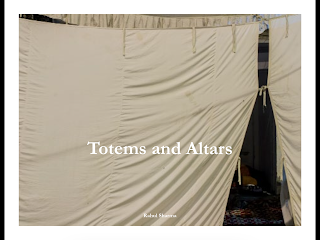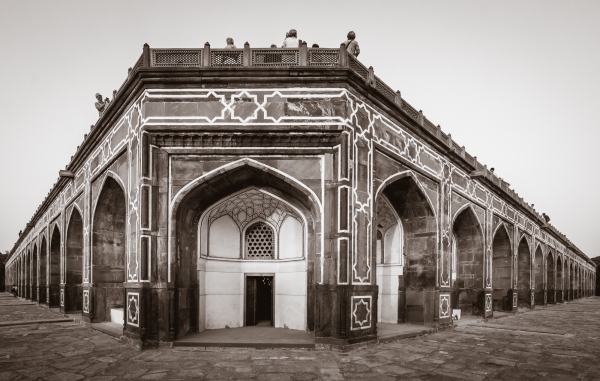In 2014, I had just moved to Delhi, working at the National Museum, right on Rajpath. Growing up, that stretch between India Gate, and Rashtrapati Bhavan was Delhi to me, because I would watch the live telecast of the ‘chabbiyan da mela’. In retrospect, what a quaint way to refer to a parade with tanks, missles, marching soldiers, and floats showing cultural vignettes from different states. Back home, the mela was the yearly fair that you went to, at the ancestral village, to commemorate clan demigods and figures of veneration. The mela of the 26th was a mela for the day India became a Republic, and we would all participate by sitting in front of the TV. Me and my Mother would wait for the BSF soldiers loading up entire battalions on a single motorcycle. In the evening, there would be the Beating Retreat, and mounted cavalry would ride to “Saare jahan se accha, hindustan hamara”. [trans: 'India is better than the whole wide world': Not Allama Iqbal's most shining moment, if I am honest, but much better than the ideological turn that came later]
At that age, it felt that way too. You know, I used to get a twinge of that feeling when the song comes to mind, until today, when I saw a video of the song being piped out on loudspeakers from the central secretariat; as the entire Rajpath was denuded and dug up to make a monstrous new facade for ‘Indian democracy’; while a pandemic that could have been prevented, literally puts a price on each breath of oxygen. Phrases like moral failure are being thrown around. I don’t think a phrase so convenient can capture the magnitude of the situation. If it wasn’t so real, one would almost imagine that the situation in India was a macabre play, written by the prime exponent of cynicism and misanthropy.
But, these visceral reactions are partly a result of helplessness. What does one do? Or more specifically, what do I do? I moved here to Amsterdam, to study Conservation of Cultural Heritage. To learn to better preserve those tangible things that inform us, and serve as traces of memory and values. How does one preserve something when it is actively being destroyed by the powers that be? Who does one preserve for, when the people involved are actively dying? Why does one preserve, when it encompasses is the tragedy of not being able to breathe, the malice of a government that tells you that sitting under a tree will provide the oxygen you need, and the horror of having the ashes of your friends and your neighbours rain down upon you?
What become of the Delhi of my mind?
My first visit to India Gate came with my friend from Delhi. We went there at 1 am in the morning, to eat ice cream. That used to be my friend’s ritual with his grandfather, when his parents were out.
I took a girl out on a date to the lawns on Rajpath. We had rum in Appy bottles; and we sat and watched the crowds pass by; kids taking rides in little toy cars, and folks taking in the cool evening breeze. We took turns relieving ourselves in the bushes on the side, the other keeping a lookout. She later told me that it wouldn’t work out between us.
I used to walk to the National Museum from Central Secretariat Metro Station my first year in Delhi.In the monsoon, the dirt path between the road and the gardens would become an impassable morass, with the combination of the rains, and pipes watering the grass even in the rain. I used to wear slippers, and learned to hike up my pants, and waddle, so that the slippers wouldn’t spray the back of my pants with the sandy mud.
Me and my classmates would bunk class, and take the bus to Khan market, which had the closest liquor store. We would get a couple of cans of beer, and go back to the gardens, and play cricket in the Fall, as government employees from the Ministry of External Affairs and Krishi Bhavan would take naps in the sun on their lunch break. I learned how to bowl off-break, never having really played much cricket before. I used to bowl smoking a beedi, because it would distract the batsman. Once, we had a Conservation vs Museology match. Conservation Won.
We would go to Andhra Bhavan in the winter, and eat the all-you-can-eat meal, and go to the IGNCA to take long naps in the sun. There would generally be exhibitions there, and we would amble down, and spend an hour or so talking shop with the folks. I used to wear high waisted pants and sandals; and one of the guys once told me I looked like a photo of his father in the 70’s.
I had a long talk with a friend about politics and praxis in art and life, sitting on the stone benches by the water. We planned to meet again, and next time go on the boats on the opposite side. We never got around to it. We had momos by the Central Secretariat metro, and then I took the bus, and she took the metro home.
I had a BSA cycle that I got for 2000 rupees, and I would bike in early mornings on the weekends. I would start near Ashram, and go on to India Gate, and down to Rashrapati Bhavan, swing past Lodhi Gardens, and onwards down home. One winter morning, before dawn, as I was passing by, I saw a solitary security guard standing on the bus stop after central station. It was foggy, and all you could see were the lights of the buildings behind him, and him lit from the light of the bus stand. I did not see his face.
2 years into my stay in Delhi, in winter, with the same local friend, I went back to India Gate. I had a pheran, shawl, and a chitrali pakol on. One of the soldiers at India Gate looked at me funny, and asked me where I was from. I saw that his uniform had J&K Light Infantry markings. I responded in Dogri. He was taken aback, because he figured I was Kashmiri. Dogras and Kashmiris don’t care much for each other. We started talking, and turned out his house was 10 minutes away from my house.
I worked on a project at Rashtrapati Bhavan for a year. Sometimes in the winter, from the front, you couldn’t see past the Jaipur Column, because the smog was so thick.
We would sometimes leave from the front entrance of Rashtrapati Bhavan, because the side entrances were too far from public transport. We would get out just right of the wrought iron gates. Once, as we got past the security barricade, a family with two kids came up to me to ask if they can go inside. I told them, ‘permission chahiye’ (you’d need permission).
My friend was into physical fitness to get the ladies, and he always talked about running from India Gate to Rashtrapati Bhavan; and how he would set it up so that as he ran up Raisins Hill, the Rocky music would start playing; and it would hit the crescendo as soon as he reached the top.
When I first got to the National Museum, I checked out a book on Delhi’s planning by Lutyens and Baker. The only thing I really remember from it was how the grade of the slope up Raisina Hill destroyed their professional relationship.
They would shut down the parks by Rajpath a couple of months before 26th January every year, and by around the 20th, it was pretty hard to even sit outside the National Museum for my Regular Chai and Samosa. We would sit with the staff of the MEA, and gossip about who got the pass to sit in the Parade.
...
If wishes were fishes, and COVID had never happened; the demolition would still have happened. It was planned before it. I would have felt the same nostalgia about the passing of the lawns and the India gate, as I do now. Political, and aesthetic difference of opinion aside, I would have bemoaned the thing, and moved on, just like I did when they demolished the Hall of Nations. Isn’t it a sign of slowly becoming a native of a city, if it changes as you remain a spectator?
Sure, I spent 4 years of my life revolving around the base of Lutyens’ Triangle: National Museum, Indira Gandhi National Centre for the Arts, Krishi Bhavan. I could tell you the best place to get chai in the entire belt, and where you could get great breakfast for 15 rupees, and what times the monkeys would come out, and where to sit in the parks so you wouldn’t get harassed by the cops and the hawkers. But that’s life, right? Things change.
I also know that folks are resilient, and make do. Sure, the shops would change, but the same folks would be there. Eventually, the entire vista would gain its own emotion and its own feeling, and eventually, things would creep back to a sense of normalcy. It’s Delhi after all, a city of cities. Many have been built, and many more will be. It is the Dehelvi zaikqa that survives.
But seeing all of this happen, at the same time is a strange mixture of feelings. There is resignation: it's done. Places I tied 4 years of my life to have disappeared. There is Anger: why do it at this time, and at this cost, when each penny could save lives by buying much needed Oxygen and Vaccines. There is the learned helplessness: The government would do it anyway. They can make an entire nation line up at ATMs at 4 hour notice, and drive a bigger migration then the British did with Partition of 1947. What are a couple of buildings and a few trees? There is nostalgia: as if going back and looking at things with rose tinted glasses would bring it back. There is frustration: I am abroad as all of this happens.
As I type this out, I still have Saare Jahan Se Accha in my head. It takes on a bitter taste, even while speaking the truth:
غربت میں ہوں اگر ہم، رہتا ہے دل وطن میں
سمجھو وہیں ہمیں بھی دل ہو جہاں ہمارا
…
اقبال! کوئی محرم اپنا نہيں جہاں میں
معلوم کیا کسی کو دردِ نہاں ہمارا!
If we are in an alien place, the heart remains in the homeland,
consider us too [to be] right there where our heart would be.
…
Iqbal! We have no confidant in this world
What does anyone know of our hidden pain?
This is all Bellyaching. I know it, because, you know, people are dying out there. I am also of that privileged Non Resident Indian class right now, and that is a whole emotional roller coaster. I am also not really an urbanist or an architect. But with each stroke, I see the Delhi I lived in, and loved and hated disappear. COVID. The Exodus. The February 2020 Riots. This.
There is malice and incompetence in the powers that be. Incompetence was always there, malice is a new addition. How does one reflect the small realities and joys of life and memory, like walking down familiar paths, and having a familiar bench, and a favourite tree in a park; when it is faced with such gargantuan horrors as India has faced in the past year?
The fundamental indecency of our government is reflected in the fact that the small moments of humanity, of love, sorrow, joy, that lived in these day to day places are completely overshadowed by the carnage upon us.










